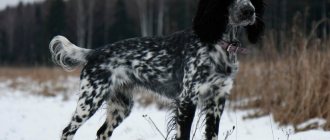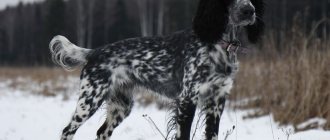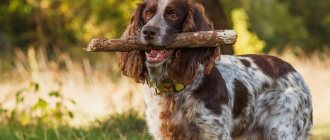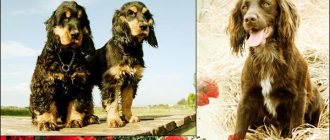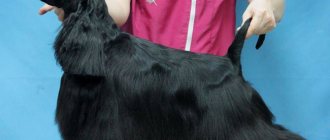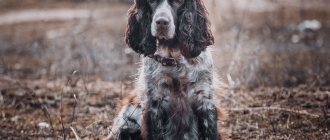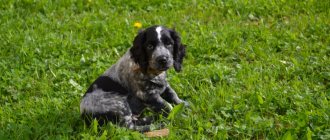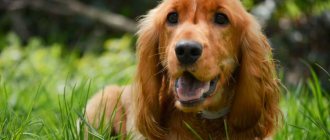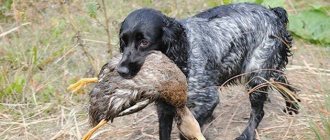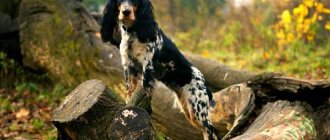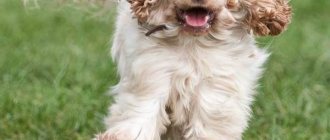Cocker spaniels include two breeds of spaniel type dogs: American And English Cocker Spaniel.
This breed was originally bred as a hunting dog in the United Kingdom. In the United States, she was bred to a different standard. Further physical changes in conformation and temperament were developed in the United States in the early 20th century, but both breeds have similar virtues, coat colors, and health problems, with few exceptions.
Description of the Russian hunting spaniel breed
Popularity 114th place among 263 dog breeds
Lifespan:
12-14 years old
Breed group:
Hunting
Height:
males: 38-44 cm, females: 36-42 cm
Country of origin:
USSR
Average price:
from 15 thousand rubles
Weight:
13-16 kg
Latest articles Cat health
Rabies vaccination for cats: choice of vaccine, necessity, schedule 01/22/2022 20 0 0
Selection and adaptation
TOP 20 best cat breeds for families with children 01/22/2022 33 0 0
Muzzle for English Cocker Spaniel
This is one of the important components of a dog’s equipment for a walk, while traveling on public transport and when visiting a veterinarian. In order not to cause harm, the muzzle must be made of high-quality materials. The English spaniel is a relatively small and non-aggressive dog, so you can choose a leather or fabric product. It is important to choose the right size so that there is no discomfort, and at the same time the dog cannot lose it. You can choose the appropriate option from the following models offered on the modern market:
- leather;
- fabric;
- plastic.
Advantages and disadvantages
- Pros:
- smart, brave, loyal, obedient;
- gets along well with children and other pets;
- not aggressive and not vindictive, rarely shows anger;
- can be kept in a house or small apartment;
- has excellent hunting abilities and a keen sense of smell.
- Minuses:
- overly energetic and active, therefore needs long and frequent walks;
- susceptible to obesity and food allergies;
- requires special care for the coat and ears, and often suffers from otitis media.
Typical diseases/problems of the breed
The English Cocker Spaniel is positioned as a healthy and hardy animal. However, representatives of the breed suffer from such ailments as:
- eye diseases: cataracts, glaucoma, keratoconjunctivitis, cherry eye, eversion/entropion of the eyelid, progressive retinal degeneration and atrophy, distichiasis;
- food allergies;
- epilepsy;
- lipoma;
- dysplasia, discopathy;
- atopy;
- otitis;
- diseases of the genitourinary system;
- melanoma;
- hepatitis;
- hypothyroidism
In addition, the English Cocker Spaniel is prone to hearing problems, skin cancer, hydrocephalus, and demodicosis.
Key facts
The Russian Spaniel is an energetic, lively, inquisitive, optimistic and friendly pet. Nature has endowed the dog with excellent sense of smell and amazing endurance, which allows it to quickly and easily find birds in marshy or dry areas.
The spaniel is an incredibly smart, loyal and obedient dog that is strongly attached to its owner. He gets along well with small children, cats, dogs, and other pets. Such a pet will be an ideal companion for an active family and is definitely not suitable for elderly and constantly busy people.
Description of the Russian Hunting Spaniel breed includes:
- high level of intelligence;
- friendliness, sociability;
- well developed hunting qualities;
- easy training and education;
- rapid adaptation to a new environment;
- unpretentiousness in everyday maintenance, nutrition, care.
If the spaniel is considered in the role of a hunter, it is worth noting such qualities as: perseverance, activity, endurance and complete obedience. The pet swims well in water, dives, and follows all the owner’s commands if it is raised correctly.
The characteristics of the Russian hunting spaniel breed emphasize that this hunting dog is hardy, energetic, patient, persistent and at the same time attached to the owner and his family.
With proper maintenance and proper nutrition, the life expectancy of the Russian Hunting Spaniel is 9-11 years. For a hunting dog this is a normal period. Long-livers occur, but not so often.
The spaniel tolerates cold well, which makes it possible to keep it in the enclosure of a private house. In the winter season, the owner needs to take care of insulating the booth, since without the proper conditions the dog can get sick.
Characteristic
Strong, active, persistent dog. She is selflessly devoted to her owner and is ready to carry out any of his orders, although she is quite emotional and active. A Russian Spaniel swims and dives to retrieve a wounded bird. Hunts and tests on swamp, field and forest game (previously the breed was even tested on the blood trail). Has good instincts and endurance. Can be a watchman (although this is extremely undesirable) if provided with the necessary physical activity. It can be trained very well, but without exercise it can become hyperactive. Some male dogs can be dominant, but with proper training this can be corrected. Calm, obedient, affectionate domestic dog, absolutely loyal to children and other pets.
History of the origin of the Russian hunting spaniel
The animal appeared on the territory of the Russian Federation during the reign of Nikolai Romanov. He was an avid dog breeder and brought various breeds of hunting and guard dogs from abroad. The result of crossing the Italian spinone and the long-haired pointer was the birth of the Russian spaniel, which, at the instigation of the tsar, acquired practical value among domestic dog breeders.
The animals were quickly discovered to have remarkable hunting qualities and the ability to work with game and birds on land and water. In particular, they were often used in catching pheasants, a favorite dish of the imperial family. For this reason, breeding hunting breeds has become a profitable and respected business.
English dog breeders were also involved in selection: they mixed spaniels from the royal nurseries with cocker spaniels. The result was offspring that had some external similarity with their Russian relatives and had similar working qualities.
By the middle of the 20th century, through repeated crossing, breeders developed two breeds of spaniels with significant distinctive features, which are exhibited separately at breeding shows. At the same time, the unofficial English and Russian groups split.
The four-legged representatives of the “castes” differ in appearance and principle of operation, which became the reason for the subsequent mixing of both species. Subsequently, Leningrad cynologists were engaged in breeding spaniels, who bred domestic and imported dogs from abroad, significantly improving the hunting breed.
However, all their achievements were destroyed by the blockade of Leningrad during the Second World War, which is why, after the victory over the Nazis, the number of dogs had to be restored almost from scratch.
In 1950, Soviet cynologists determined the phenotype of the hunting breed and registered the standard for the appearance of the spaniel. Since 1971, mating Russian hunting dogs with other breeds of spaniels was officially prohibited, and this made the breed independent.
In the early 60s of the last century, dogs became very popular among Soviet hunters. Smart, loyal, obedient pets were and remain easy to transport; they take root well in small apartments.
At the moment, the animal population numbers more than 60 thousand individuals; the main breeding centers of the breed remain: Moscow, St. Petersburg, Yekaterinburg, Saratov, Samara. To improve knowledge about the hunting breed in America, the Spaniel Club was opened in 2000, where spaniel owners can register their four-legged friends.
History of the breed
The first representatives of the spaniel family came to Russia at the end of the nineteenth century. It is known that Grand Duke Nikolai Nikolaevich himself, who owned a black cocker spaniel, was a connoisseur of these hunting dogs.
With the advent of the twentieth century, not only cocker spaniels, but also springer spaniels appeared on the territory of the USSR. In the thirties, many hunting enthusiasts acquired spaniels that did not fit any established standard. These dogs are the result of crossing Springers and Cocker Spaniels.
For a long time, the standard of the new breed was not determined. Breeders worked to improve it. The main center of selection work was in Leningrad.
When the Great Patriotic War against the Nazis broke out and the northern capital of the Soviet Union was under siege, almost all purebred Russian spaniels were destroyed. The number of representatives of the new species was on the verge of complete extinction.
Thanks to the efforts of spaniel connoisseurs, the endangered species has been revived. Its numbers and popularity have been restored. In 1949, work was underway to define the standard. In 1951, the selection and development of the Russian spaniel was completed and the first standard was officially established. Over the following years, it underwent changes several times.
Appearance of Russian hunting spaniels
General impression
In life and in the photo, the Russian hunting spaniel is a strong, muscular dog of an elongated format. At the withers it is taller than English Cocker Spaniels, but smaller than the Springer.
Since Soviet breeders paid main attention to endurance, courage, and search characteristics, the eared animal looks a little primitive. Of course, he is far from the glamorous Americans, but he is not without restraint in grace and lightness of charm.
Head
Oval in shape, elongated, wide, with a well-defined skull, the head of the Russian Hunting Spaniel is quite large, while it tapers towards the nose. The forehead is convex, the arches above the eyebrows are well developed. The line of the muzzle is parallel to the line of the forehead. The transition between them is noticeably pronounced.
If you look at the head from the side, you can see that the upper lip is shaped like a rectangle with slightly rounded corners. The lips and nose are black or light brown.
Neck
Moderately long, well developed muscles.
Torso
Sturdy and slightly elongated. The topline is sloping, the back is wide, the loin is short, smoothly turning into a sloping croup. The chest bone is wide, the pelvis is taut.
Front and hind limbs
The front legs are straight, bony and parallel. Elbows set back. The forearms are straight, the pasterns are voluminous, slightly inclined. The length of the legs is ½ the height of the animal at the withers.
The hind limbs are straight and spaced slightly wider than the front ones. The spaniel has short shins and voluminous, straight-set metatarsals. The paws are rounded and arched, the toes are pressed tightly against one another, separated only by long hairs.
Tail
Mobile, thickened at the base. It decreases by half after birth and is located along the line of the back when walking.
Movements
Free, energetic. Animals move well both on land and in water.
Wool
The coat is elongated and noticeably wavy. The guard hair is shiny and adheres well to the animal's body. The head and all limbs are covered with a short and dense coat.
There are longer hairs on the back, croup, sides, and top of the neck. The chest, lower neck, groin and back of the paws are covered with abundant hair, forming dewlaps.
Colors of the Russian Hunting Spaniel
The breed is characterized by 3 types of colors: uniform, 2- and 3-color. Animals with solid colors are dark red, brown, black, and white markings on the throat or sternum are acceptable.
Two-tone spaniels combine similar colors, but they are broken up with distinct light spots. Tricolor - black and white, brown pets with a slight tan. The color may contain inclusions that do not match the main tone of the coat.
Russian hunting spaniel size
The height of the Russian Hunting Spaniel at the withers for males reaches 39-45 centimeters, for females – 35-40 centimeters. The weight of a Russian hunting spaniel in adulthood does not exceed 22 kilograms.
Breed standard
The Russian Spaniel is small in size. The height of adult individuals is 36-44 cm , weight is about 9-16 kg .
The neck should be of medium length without skin folds. It holds a moderately long head with an oval-shaped skull. The long ears are hanging, the lower part is rounded.
The forehead is slightly convex. Brown eyes have an oval shape. Protruding eyes are a serious defect. The muzzle is quite wide and long.
The nose is preferable to black, although light brown is acceptable. Scissor bite.
The lower back is slightly convex, the back is straight. The stomach is slightly tucked. The chest is long and deep, not too wide. The tail is docked at half its length. The spaniel keeps him close to the line of his back.
Legs straight, parallel. Paws are round in shape. Movements are free.
The skin is without looseness or folds.
The coat is long and close-lying. Slight waviness of the top hair is allowed. The coat is soft to the touch, beautiful and shiny in appearance. Lush feathers are present on the ears, belly, limbs, tail and chest (lower part).
Three types of color are allowed:
1. Tri-color - black and brown with tan, white with marks and strokes. 2. Two-color - red-piebald, brown-piebald, black-piebald. This color can be speckled (the spots are blurred) or contrasting (large marks of the main color on a snow-white background). 3. Single color - red, black or brown.
Character of the Russian hunting spaniel
The Russian spaniel is a wonderful hunter, but in the house the dog becomes a devoted, reliable friend and companion for all family members. He quickly becomes attached to a person and tries to accompany him everywhere.
The dog loves to swim, play and frolic. If the animal is kept in a country house, it must be allowed to run freely around the site or a large fenced space.
The spaniel gets along well with small children and happily gives them all his free time. He runs, jumps, plays, and carries out all the orders of his little masters. You can leave your pet unattended with your child, as the spaniel is very friendly and would never cause any harm to his young friend.
The spaniel treats other pets in the home with patience, but he certainly won’t show the same respect to other people’s cats and will definitely kick them out of the entrusted territory. The dog does not get along with guinea pigs, hamsters, birds - the hunting instinct takes over over time, and small animals die.
In general, this is an intelligent, hardy, strong, active pet with a remarkably developed instinct of a born hunter. The character of the Russian hunting spaniel is peace-loving, loyal, accommodating, he is easy to train, loves unrequitedly and completely obeys a person.
Owner reviews
Reviews of English Cocker Spaniels are positive. The Cocker is a true companion with whom you can go anywhere in the world. Representatives of the breed easily find a common language with other dogs and do not show aggression towards them.
Cocker owners advise: if a dog is not purchased for breeding, it is advisable to castrate or sterilize it. The English cocker has a perfect sense of smell, and therefore temptations follow him everywhere. The dog may suddenly take off from its place and rush in search of a female dog in heat.
This behavior can also be caused by another smell that interests the pet. To prevent the dog from paying with his life in pursuit of prey, people recommend walking cockers on a long leash/roulette.
Education and training
As a rule, spaniel puppies acquire their own home and owner by 3 months of age. In the first days, the owner needs to show the baby as much attention, care and patience as possible, realizing that parting with the mother was not easy.
The puppy quickly gets acquainted with the new living conditions, its inhabitants and ceases to be afraid of extraneous sounds. Already at this time, the owner needs to start disciplining the pet - without shouting or physical punishment, teach it standard commands.
It is important to realize that a hunting dog must grow up obedient, it must have one owner with unquestionable authority. For this reason, one person takes part in training a pet, and not the whole family. It is unacceptable when someone forbids something to a dog, while another, on the contrary, allows and encourages it.
From the very beginning, the dog needs to be given a place to eat and sleep. You should not allow her to sleep on her owners’ bed or eat human food from the table. It is almost impossible to re-educate a pet after bad habits have formed.
Raising and training a Russian hunting spaniel is a labor-intensive, but very interesting task. The animal grasps everything new on the fly and completely obeys its owner. When training, it is important to use several methods that force the spaniel to remember commands:
- incentive
– when the desired action is encouraged by a treat;
- mechanical
– in studies, force is used (for example, pressing on the body, but in no case a blow);
- contrasting
– the two previous methods are combined;
- imitative
– an inexperienced dog copies the actions of a trained dog.
After mastering the training course, the spaniel will follow orders without the use of force or treats. The dog must be praised for every excellent result. Excessive punishment for disobedience is unacceptable, otherwise there is a high risk of completely losing contact with the pet.
Physical punishment can be light pressure on the dog’s back, a gentle blow to the rump with a wooden rod with a dissatisfied intonation in the voice.
Commands must be pronounced in a confident tone, loud and clear. It is impossible to replace them with orders that are similar in meaning, otherwise the animal will become confused, and the learning process will become significantly more complicated and extended over time.
Looking for a Russian Hunting Spaniel? Find your pet from 2 offers As a gift
Key points in training
A Spaniel puppy chooses one owner to obey. But for this, a person needs to show his leadership qualities and show the dog the existing hierarchy in the family.
In order for your pet to understand that the people in the house are the main ones, you need to teach him some habits:
- Feeding is carried out only after the whole family has eaten;
- You can enter the room only after everyone has entered;
- Walking, sleeping, and playing on human furniture is strictly prohibited.
Representatives of the breed tend to dominate. All attempts to dominate or show character must be stopped. However, crude methods will not work. Enough with a stern look, a firm word, and deprivation of treats.
The owner needs to learn not to react to begging, puppy dog eyes, and acting techniques.
Raising a dog begins from the first days of life, but training begins from 3-4 months , when the puppy remembers its name. You can contact the kennel club and take the “Dog in the City” course. It will help the dog socialize and the owner to establish contact with the animal.
For a hunting dog, it is important to unquestioningly follow basic commands:
- "Near";
- "To me";
- "It is forbidden";
- "Sit";
- "Voice".
Read about how to properly train a dog in the article: “Training a puppy: effective methods from dog handlers, learning commands at home.”
If the owner has not achieved obedience, the pet is unlikely to become a good helper. To train individual hunting skills, it is worth contacting specially trained people.
Health and diseases of the Russian hunting spaniel
The general condition of the pet is determined by living conditions, nutrition, and the efforts of the breeder. Your spaniel should be taken to the veterinarian 2-4 times a year for tests and a general examination to identify health problems at an early stage of development.
Possible diseases
The hunting breed is predisposed to the following diseases:
- Obesity
– the reasons are unbalanced nutrition, lack of exercise and violation of the regime.
- Food allergies
– new foods should be introduced into the dog’s daily diet carefully, and if an adverse reaction from the body is detected, they should be immediately excluded.
- Otitis
– inflammation of the ear from the inside or outside.
- Blockage of the paraanal glands
– if the problem becomes chronic, then they resort to surgical intervention and their removal. All early stages are treated with medication.
- Mycosis
– the disease is provoked by parasitic fungi that affect internal organs and skin.
- Leptospirosis
– a bacterial infection affects the kidneys.
To prevent most diseases, your dog needs to have all routine vaccinations on time. Regular treatment of the animal with drugs against internal and external parasites is also required.
Reproductive health
In the Russian Spaniel, sexual maturity occurs at 9 months of age, but the first mating is not recommended before 1 year. Pregnancy lasts 55-73 days, but most bitches give birth 59-60 days after mating.
If you do not plan to breed the Russian Spaniel breed, it is better to castrate or sterilize the dog. After the operation, the animals will lose the ability to reproduce and become much calmer.
Characteristic diseases
The lifespan of an American Cocker Spaniel is from 14 to 16 years. Diseases are genetic and congenital.
Due to mistakes in training, a dog may exhibit behavioral pathologies - aggression, panicking. Dogs sometimes suffer from skin asthenia (Ehlers-Danlos syndrome). When the disease occurs, the skin loses its elasticity, sensitivity and strength.
There is a lack of carnitine, which causes the heart muscle to weaken. This causes dilated cardiomyopathy. Sometimes there is excessive inversion of the eyelid due to drying of the cornea (keratoconjunctivitis), skin infection on the extremities (pododermatitis), and inflammation in the outer ear (otitis externa).
Diseases of the intervertebral discs lead to ruptures and displacements, so there is a risk of paralysis of the dog. Puppies may have dysplasia (improper formation of the retina), and adults may have melanoma. It is a not very common type of cancer. Its development occurs from skin cells that produce melanin.
Features of feeding and diet
The Russian spaniel has an excellent appetite and is ready to eat food around the clock. To prevent obesity, it is important to correctly calculate the amount of food and take care of a sufficient amount of physical activity.
So, for an adult animal leading an active lifestyle, 250 grams of dry food per day is enough. If natural food is given, its quantity should not exceed 60 grams per 1 kilogram of the dog’s weight. An increase in the norm is only possible for pets recovering from illness, nursing bitches and animals that live in an enclosure.
Three times a month, the Russian Spaniel requires unloading. On such days he should receive half as much food. The dog's diet should include beef - it is given several times a week, raw or boiled. It is better to take away a bird caught during a hunt so that the spaniel does not develop the habit of dealing with birds on its own and not bringing it to the owner.
Otherwise, the animal is fed in the same way as other hunting dogs - boiled sea fish 3-4 times a month, low-fat fermented milk products 2 times a week, cereal porridge boiled in water or broth every day.
The animal should be given vegetables, fruits, greens, boiled or raw. Sometimes you can add a chicken egg to your diet in the form of an omelet or mixed with dairy products.
Spaniels also love rye crackers, which owners often use as a reward for correctly executed commands during training. Dried fruits should be given in exceptional cases: the dog must understand that this is a “delicacy” and must be earned.
Mating
Mating of a Russian spaniel follows the same rules for most breeds. The owner of the bitch must carefully monitor when the dog begins to heat. Ovulation usually occurs 8-10 days after the appearance of vaginal discharge. It is important to prepare for the moment of mating. It is advisable for the male to know the bitch in advance and be friends with her. A few weeks before mating, deworming should be carried out. If the bitch has problems with excess weight, this also needs to be dealt with. The easiest way to do this is by increasing the amount of physical activity and limiting the consumption of flour and high-calorie foods. The condition of both animals must be satisfactory. This will contribute to a successful mating, the birth will go smoothly, and the puppies will be healthy.
Care and maintenance
A spaniel can be kept in a house or apartment, provided it is given frequent and long walks outside. The puppy needs to immediately be allocated a place in the home: it should be secluded, protected from heat and drafts. It is important to protect a hunting dog from strong foreign odors, which can negatively affect the pet’s sense of smell.
The dog's sleeping place should be clean, with a water bowl and food bowl freely available. The dog should have favorite toys, a leash, a collar, a hair brush and hygiene products. A spaniel does not require clothing: its thick coat can protect it even in severe frosts.
An active and energetic animal requires regular and frequent walks lasting at least an hour. The spaniel loves to jump, run and play; in urban areas there are special areas for this. Periodic trips to a field or forest would be appropriate, where the animal can run around without a muzzle or leash, or swim in a pond.
The difficulty in caring for and maintaining the Russian hunting spaniel is the coat, which quickly becomes dirty and forms tangles. But if you accustom the animal to the procedure of bathing, combing and cutting from an early age, then no special problems will arise.
Particular attention is paid to the ears. They need to be cleaned several times a week with damp cotton pads, and ventilated once every two weeks by waving them from side to side for several minutes.
Teeth are brushed with a brush and a special paste several times a month. To prevent the formation of tartar, the dog is given special bones, crackers, hard fruits and vegetables.
The claws are trimmed once a month with special scissors or tongs, and the dog sharpens them on the asphalt while walking. If this does not happen, you can polish them with a hard file.
Hunting
Russian spaniels are designed for hunting game birds:
- swamp-meadow game (great snipe, snipe, humpback, corncrake, marsh hen (crakes, shepherdess);
- field game (quail, gray partridge, pheasant);
- upland game (woodcock, black grouse, wood grouse, white partridge);
- waterfowl (duck).
While searching for the bird, they work within gunshot and energetically lift it onto the wing. Their small stature, lack of stance and great hunting passion make them indispensable when hunting in support structures, on running birds, and quite effective when hunting any other feathered game. After a successful shot, the spaniels find and return the dead game to the hunter.
Distinctive abilities are:
- find a bird, using its smell or the smell of its track to rise to the shot and to search for a dead bird or wounded bird;
- speed and energy of the search;
- the ability to rationally, taking into account conditions, search areas within a rifle shot;
- sharp animation, rapid wagging of the tail at the moment of sensing the bird or its tracks, and a quick, energetic movement in the direction of the bird, ending with a throw to lift it onto the wing;
- energy and reliability of work in searching, when working on poultry, picking up wounded animals and performing feeding in any conditions, including in “strong places” and in water;
- the ability to quickly and reliably bring found game.
Russian spaniels also hunt white and brown hares.
Tips for choosing a puppy
It is better to purchase a baby Russian spaniel from official breeders. Here you can get acquainted with the pedigree of the parents, their achievements, diplomas from exhibitions and more.
Before purchasing a puppy, it is recommended to visit the nursery several times and evaluate the living conditions. Be sure to watch how your baby eats. If he has no appetite, it means he has health problems. A healthy dog's bowl always remains empty.
At 2 months of age, the spaniel stands well on its feet, runs quickly, and takes part in what is happening around it with great interest. Choose a Russian Hunting Spaniel puppy with a clearly visible hump on the nose - this is evidence that over time the muzzle will stretch to the desired size. Individuals with straight or snub noses usually grow up with a short muzzle, which is considered a defect.
Among the pack of puppies, it is easy to spot future leaders. Such dogs become excellent hunters and loyal friends. Children are tested for courage by clapping their hands strongly in silence or by turning them over on their backs and holding them in this position for several minutes. Puppies with the makings of a hunter will react calmly to noise, but will perceive physical impact with obvious anger and will try to get back on their feet.
When choosing, another “test” is also appropriate - waving a rag in front of the puppy’s nose. The potential leader will immediately sense the “prey” and will not let it pass, clinging to it with his teeth.
How to choose a puppy
The choice of a puppy depends entirely on the financial capabilities and wishes of the potential owner. You need to decide on the gender of your pet. Males are better suited for hunting, but they are more capricious. Bitches are usually softer and can give birth.
In addition, it is worth choosing the puppy’s class in advance. Not only the dog’s future career depends on it, but also its cost. There are 3 classes that are assigned to an animal a couple of months after birth:
- Pet class - dogs with minor deviations that do not prevent them from becoming good pets;
- Breeding class – animals with ideal external characteristics, fully complying with the standard, suitable for breeding;
- Show class - pets with a good pedigree, born champions and prize-winners, their future career is exhibitions.
A puppy can be purchased at the age of 2.5-3 months. Small dogs are easier to train and adapt to their needs. But there is a lot of trouble with them, including vaccinations and special feeding. Experienced dog breeders prefer to buy older animals (5-6 months), but in this case problems with training may arise.
A good breeder will provide a package of necessary documents, tell you about the litter and parents, and help you decide on your future pet. The kennel has the right not to sell a dog if the potential owner does not meet the criteria or is not suitable to raise the dog .
Puppies will always be playful, perky and active. Healthy dogs must be clean, meet the standard and have no obvious pathologies. The cost depends entirely on the class of the pet: from 3,000 to 20,000 rubles .
Breeding
According to statistics, spaniels are the smallest number of street dogs. Thanks to strict selection rules, people successfully manage to develop and improve the quality of the breed.
To obtain permission to breed hunting dogs, animals must be subjected to several tests on various types of game. After successfully passing through the hunting club, they will be matched with a worthy match.
Puberty of a dog occurs by 8-9 months, but mating is not recommended at such an early age; it can result in low-quality puppies. It is advisable to start crossing when the dog reaches the age of two years.
But there is no need to mate frequently; this can lead to exhaustion of the animal’s body and also reduce the quality of the litter. A male can do it 2 times a year, and a female can do it 1 time.
Expert opinion
Anna Abramenko
An avid dog lover. Experience in veterinary medicine since 2009.
Ask a Question
Owners of girls need to be aware that pregnancy in a dog under two years of age provokes a arched back and underdeveloped paws. It is advisable to have the first mating before the age of 4 years.
If this is not done, the dog’s hip bones will fuse, which, in turn, leads to complications during future births. The most fertile period for females is between 4 and 7 years of age.
Colors
There are 3 types of breed depending on color:
- Spotted - on a light gray, white background, large or small marks are visible throughout the body. The more precise name of the color is determined by their shade. This type can be found in two versions:
- speckled (small frequent marks);
- contrasting (clearly defined spots).
Expert opinion
Anna Abramenko
An avid dog lover. Experience in veterinary medicine since 2009.
Ask a Question
As dogs of the second color develop with age, they develop small markings and become difficult to distinguish from mottled dogs.
- Plain - sometimes with white markings on the limbs, throat, belly and on the forehead, chest, muzzle and tip of the tail (for example, black and white - light on a dark background).
- Tan marks are red markings on certain parts of the dog’s body: paws, ears, under the tail, above the eyes, cheeks and chest. The most popular option is black and red tan.
Color varieties:
- brown - it is very rare to find such a dog.
It has several shades:
- coffee;
- hepatic;
- chocolate.
- black is a fairly popular color among the breed;
- red – peculiar, currently uncommon.
Cupping
There is no clear point of view regarding this topic. Previously, this procedure was considered mandatory, because the dog could damage its tail while hunting. But, over time, the breed began to be purchased more often as pets or for participation in exhibitions.
In this regard, there is no longer any urgent need to dock dogs' tails, because at home or at an exhibition the chances of damaging them are low. If, after all, the purpose of purchasing a Russian Spaniel puppy is to help in hunting, then it is advisable to dock its tail in the first 2 days of life.
During this period, the operation is as painless as possible, the baby loses a little blood, because at the age of several days the blood flow in the tail of dogs has not yet had time to develop as it should.
Older puppies are given local anesthesia during the procedure, and at the end the wound is sutured and bandaged. As a rule, the tail is cut by half or 3/5 of the length.
